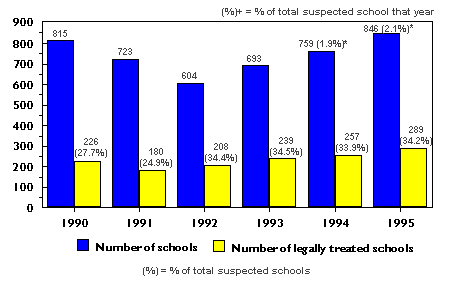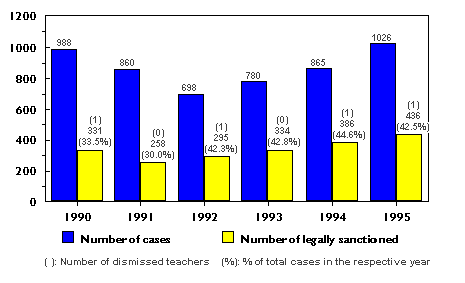
Fig. 1. Number of public schools where corporal punishments were suspected, and legal sanctions.
Noboru Kobayashi, Masako Tanimura, and Yukio Shimauchi
Noburu Kobayashi is Professor, Konan Woman's University (Puericulture); Director, Child Research Net, Tokyo, Japan. Masako Tanumura is Director, Department of Child Ecology, National Children's Medical Research Center, Tokyo, Japan. Yukio Shimauchi is Director, Educational Research Center, Benesse Corporation, Tokyo, Japan.
Corporal punishment can occur in the home, at school, and even in institutions for handicapped children. The history of corporal punishment dates back probably to the earliest days of ancient Greece and Rome in the West, and naturally Japan has a similar history, although it is difficult to trace this form of punishment to such an early time. It can, however, be traced to the 7th Century.
Corporal Punishment in Japanese Schools
Corporal punishment in the schools of Japan has been reported by the Japanese Ministry of Education. Schools suspected of using corporal punishment during the years 1990 and 1995 number from 600 to 850 per year, or about two percent of all public schools in Japan. Of these schools, 25% to 85% received legal sanctions (Fig. 1).

The number of cases of corporal punishment reported between 1990 and 1995 was approximately 700 to 1000 cases a year. Although 30% to 45% of the teachers responsible for these cases received legal sanctions, only one or none was dismissed each year (Fig. 2). These two Figures show that corporal punishment has been increasing during the past five years or so.

The Educational Research Center, Benesse Corporation, conducted a retrospective survey of approximately 600 mothers of 13-year-old children. The survey revealed that 44% of the children received no corporal punishment during primary school (ages 6 to 12 years), but 56% of them had been punished in this manner once (or more) since that time. The number of punished children increased with age. Boys were more often victims than girls, but among the teachers involved, neither sex predominated.
This study also analyzed the feelings of parents and children regarding the punishment. Nearly half the children felt the corporal punishment they received was severe or too severe for what they had done. Among the children, 20% developed ill-feelings for their teachers, and 30% became dissatisfied with them. While 50% were able to accept or tolerate corporal punishment, 30% later came to dislike their teachers. Only 5% continued to like their teacher after being punished.
Of the mothers, 50% were able to accept or tolerate the corporal punishment because their child had misbehaved, 16% denied their child had misbehaved, and only 20% protested the teacher's use of corporal punishment. Also, only 14% of the mothers felt that punishment was an effective discipline tool, 68% approved of occasional punishment, and 17% disapproved of corporal punishment on any occasion.
The rate of corporal punishment acceptance was higher among fathers (50%) than mothers (30%). It was noted that the shorter the school career of the father, the higher his acceptance rate.
In general, parents considered "mild corporal punishment" acceptable, but they did not approve of striking, punching, beating, or kicking. Milder corporal punishment means spanking on the bottom and also kneeling or being forced to stay after school and study, which are acceptable to parents. Parents believe, however, that corporal punishment is always permissible in cases such as delinquent behavior, dangerous activities, or bullying.
Corporal Punishment in Japanese Homes
Corporal punishment no doubt occurs in Japanese homes, but so far there is no well-documented study on how school children are treated in their homes. As expected from the parents' disapproval of corporal punishment in the previous section, we can only imagine that while corporal punishment may occur at home, it is probably infrequent (if at all).
The following epidemiological study sheds light on corporal punishment (considered child abuse) of younger children at home. Some 435 cases of child abuse encountered at pediatric departments of general and children's hospitals, and practicing pediatricians, were registered with the Department of Child Ecology, National Children's Medical Research Center, and the National Children's Hospital from 1986 to 1995. According to the rationale for abuse given by the abuser, 36.3% stated "discipline and education" as the reason(s), or used the child's behavior as their excuse (Table 1). Such treatment is considered corporal punishment when it occurs in the home.
| Rationale | Percent |
| A. Discipline given for behavior/pesonality/character problems | 20.0 |
B. Problems relating to the child him- or herself:
|
16.3 28.3 6.4 |
| C. Problems of parents themselves, including family background (125 cases) |
28.7 |
| D. Others or No Statement (224 Cases): Sexual Abuse and Others Intention and Probable Intention of Education or Discipline Given as Reason: A + B1 158 |
36.3 |
Discussion
Corporal punishment at school is legally prohibited in Japan. The first law prohibiting it was passed in 1879 -- 118 years ago -- when a western-style education system was first introduced. It was repealed, however, in 1885. It was reinstated in 1890, repealed again in 1900, and once again reinstated in 1941, during the war period. These legal reversals occurred each time the education system was changed.
Since the 1940s, therefore, and particularly after World War II, when the American education system was reintroduced, corporal punishment has continuously been legally prohibited -- much earlier than in other developed countries (Table 2).
| Year | Legal Considerations |
| 1868 (72) | Beginning of modern education |
| 1879 | Law prohibiting corporal punishment enacted |
| 1885 | Repeal of law prohibiting corporal punishment
(in loco parentis) |
| 1890 | Law prohibiting corporal punishment reinstated
(law for primary schools) |
| 1900 | Law prohibiting corporal punishment repealed (again) |
| 1941 | Law prohibiting corporal punishment reinstated (again) |
| 1945 | Corporal punishment continuously prohibited since the end of World War II. |
| Re: France (1887), Germany (1970), Sweden (1979), UK (1986) | |
Especially in 1948, the Ministry of Justice announced that striking, punching, or kicking children, or making them kneel or stand straight and rigid for a long period of time, or refusing permission for them to visit the lavatory or eat lunch, were all specifically prohibited.
While corporal punishment is legally prohibited in Japan, this type of punishment still occurs in our country. Corporal punishment may cause the following problems and risks for children:
One must consider why, although legally prohibited, there is still corporal punishment in the schools of Japan. The following are the three main reasons why eliminating corporal punishment is so difficult.
Corporal punishment at home should be treated on an equal basis with child abuse in general. Discussion on this point, however, is left for another paper.
Teachers and parents involved in corporal punishment are usually in stressful situations of various types; a system to support them emotionally as well as physically, therefore, is one of the important prerequisites for solving this problem. Such a program should be organized within the school system for teachers and at the community level for parents.
Conclusion
Corporal punishment, although legally prohibited, is still a problem at schools and in the homes across Japan. Programs must be put in place to eliminate corporal punishment, particularly since the Children's Rights Treaty was adopted in Japan.
Bibliography
Sakamoto H. Study on corporal punishment [in Japanese]. Sanichi Shobo Pub., 1995.Present situation of school children's guidance problems and Ministerial policy [in Japanese]. University of Education and Science, Government Report, 1995.
Fukaya K. Corporal punishment monograph: Primary school children now [in Japanese]. Educational Research Center, Fukutake Shoten (Benesse Corp.), 1986.
Tanimura M. Registration report on child abuse in Japan, 1997 (personal communication).